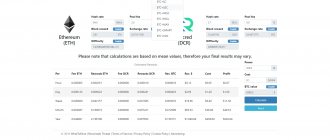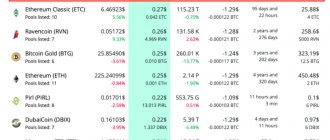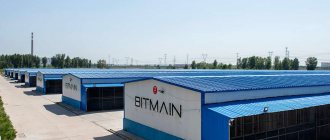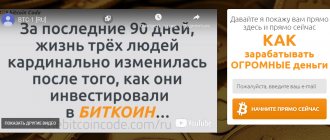Suprnova: history of the pool and its features
The history of mining with Suprnova began in 2020 – at the dawn of the popularity of cryptocurrencies and their mining. Initially, the site’s developers focused on working with Ethereum, but later, as altcoins appeared and the overall capitalization of the digital asset market grew, other coins began to appear.
Interesting! According to the decision of the platform team on Suprnova, it is not possible to mine Bitcoin. The absence of the most capitalized coin in the pool is explained by the desire to give way to altcoins. Alternatively, the site can work with direct forks of Bitcoin (Bitcoin Cash, Bitcoin Gold, etc.).
Currently, 40 cryptocurrencies are being mined on Suprnova.
Representatives of the site do not deny the possibility of further expanding the list of coins available for mining. Unlike most similar sites, the pool team offers its support. You can contact them via Twitter. The address of the resource administrator is published on the main page of the site.
Mining pool Suprnova – review…
Suprnova is a mining pool founded back in 2020 that allows miners to mine 26 cryptocurrencies. And for some coins, mining of several encryption algorithms is available. For example, the Verge cryptocurrency can be mined through 3 algorithms Lyra2REV2, X17 and Myriad-Groestl, and DigiByte mining through the same Myriad-Groestl, Qubit and Skein.
It is these capabilities, coupled with Suprnova's work experience, that make him one of the most sought-after resources in the industry. It is also worth noting that Bitcoin and Ethereum are not mined through this service.
The site structure consists of 2 layers. The first layer is the main page suprnova.cc, which has a very simple and clear design (see picture below).
The second layer is the page from which mining is configured. Its address depends on what currency you will mine. For example, if you select and click on the “Start Mining” button in the Bitcoin Gold line, then the page name will be btg.suprnova.cc, if you select Zclassic, then it will be zcl.suprnova.cc (see the picture below).
Unlike most mining pools, Supernova pool requires pre-registration. We will tell you how to register below.
Technical features and interface
The creators of Suprnova focused on the international direction of work.
To ensure access to the pool, it was decided to activate several servers that allow mining coins without any difficulties associated with the user’s geographic location. The geography of users is as wide as possible: from the USA and Europe to Asia and Australia. The occurrence of any technical access difficulties is resolved by a working group of Suprnova technical specialists. When appropriate demand for work is identified, new servers are activated.
The pool interface is intuitive. The development of a visual display of functionality was carried out taking into account the requirements for sites aimed at working with users of different levels of professional competence.
On the start page of the pool, a field opens with available cryptocurrencies. Information is displayed next to each item, displaying the following information:
- ticker;
- name of the coin;
- mining algorithm;
- number of active workers;
- pool hashrate;
- network hashrate.
The selection of a suitable position is carried out by pressing the “start mining” key.
The system independently informs users about the presence of certain features of working with a specific coin. For example, this could be an announcement about adding the ability to mine through a new algorithm or technical features related to the current state of the pool.
How to withdraw funds from Suprnova
The pool offers two withdrawal options: automatically and manually. For automatic transfer, you need to set a withdrawal threshold. Each transaction will incur a fee of 0.0001 BCC (for Bitcoin Cash). Other coins will have different values. They are listed next to the “Automatic Payout Treshold” item. The higher you set the threshold, the longer the coins will be stored in the pool, and the less often you will pay network fees.
The window for manual withdrawal of funds is below. Here you indicate how much you want to withdraw and the recipient's address. To confirm, enter the PIN you provided during registration.
Cryptocurrencies for mining with Suprnova
All cryptocurrencies presented in Suprnova are the result of a long choice on the part of the project team. Coins with an appropriate level of liquidity are allowed for listing. Additional criteria for obtaining admission of coins to the site are:
- profitability of production;
- high demand;
- lack of high technical equipment requirements;
- mining efficiency in the long term.
Further expansion of the list of coins will be carried out in accordance with previously stated standards.
Registration in Suprnova
To start registering on Suprnova, you need to go to the main page. The registration button becomes available after going to the section of any coin using the “start mining” button. On the page that opens, you need to pay attention to the “guest” button. After clicking on it, the user can log in (if an account already exists) or register (if the page has not yet been created).
To create an account you will need to enter the following information:
- - Username;
- — password (and its repetition);
- — email (and its repetition);
- — four-digit pin code.
Additionally, you will need to accept the rules for using the site. Once all fields are filled out, the application will be processed by the system and the user, through confirmation of the email address, will have access to the full functionality of Suprnova.
Registration in the Suprnova pool
Multi-coin pools are characterized by the fact that one account is enough to mine any coin from the list presented on the resource. There are multipools in which switching to mining a particular coin occurs automatically. The transition occurs to the altcoin that is currently most profitable to mine. There is no automatic switching on Suprnova, so the pool participant must choose the coin himself.
To register on the pool, you need to click the “Start Mining” button next to any of the altcoins.
We get to a mining server, for example, Bitcoin Cash.
In the upper right corner, click on the down arrow next to “Guest”. Select “Sign Up” from the drop-down menu. The registration form opens.
In it you need to fill in the fields “Username”, 2 times “Password” (it must be strong), 2 times “Email”, “PIN” (it must be remembered or saved in a safe place). Finally, check the box to agree to the terms and conditions. Click the Register button.
The pool reports that the account has been created and prompts you to sign in to the account. You must enter your email address and password.
Setting up Suprnova and getting started
To start working with Suprnova, you will need to download the miner.
Which one depends on the coin the user is interested in mining. The site offers its users the opportunity to conduct anonymous mining of funds, which is especially relevant for residents of jurisdictions whose regulators have a negative attitude towards cryptocurrencies. Mining becomes available only after appropriate configuration of the miner program. To do this, you need to make adjustments to the bat document that appears after unzipping the files. It specifies the worker parameters. *A worker is initially created in the user’s personal account in the My Workers section. The password specified for it will also need to be written in the bat file.
You can see the nuances of coin mining in the Dashboard section - it displays information about the technical details of mining and other information for maintaining statistics.
Mobile clients
Mobile clients for the Suprnova pool exist only for Android OS.
Suprnova Pools Mining Monitor allows you to track mining statistics on the Suprnova.cc pool, monitor hashrates, walkers, balance, payouts and much more with graphs.
Suprnova Monitor does the same thing as the first program. It just has a different author.
How to withdraw money Suprnova
Before withdrawing from Suprnova, each user should carefully read the nuances of creating an application.
By default, the system sets a minimum threshold of 0.002 ZEC. In fact, if necessary, it can be adjusted. It is important to know that Suprnova does not have an internal wallet - in order to be able to transfer earned funds, users will need to independently register on a third-party service for storing cryptocurrencies.
Important! User experience indicates the ineffectiveness of technical channels for withdrawing funds to z- or x-wallets. The recommended option is t-wallet.
The withdrawal itself is carried out automatically. The system compares the user's current balance with the barrier data. If they match, an application is created. Users have the opportunity to independently adjust the withdrawal barrier in their personal account.
Important! Suprnova took care of expanding the control capabilities of the mining process for users. For this purpose, two mobile applications were presented to the public, with the help of which current system indicators can be monitored. Both clients (Suprnova Pools Mining Monitor and Suprnova Monitor) are available on Google Play. Differences in the interface and some functional details allow users to choose the best option for the job. There are no mobile control options for Apple users.
Withdrawing funds from Suprnova
It won’t take you long to figure out how to withdraw from Suprnova. Withdrawals are set up automatically. Once your Suprnova balance reaches the level specified in your account settings, funds are automatically transferred to your external wallet. Therefore, there should be no problems with how to withdraw from Supernova. The main thing is to register the t-purse, not the z- or x-purse.
In order to have constant access to your account data and mining statistics, you can download the ZECcoin client on the official website.
Mobile client
If you do not have the opportunity to constantly be near your PC and view statistics online, then you can download the mobile application to your smartphone. Two similar applications from different companies have been developed:
- Suprnova Pools Mining Monitor;
- Supernova Monitor.
Mobile application Suprnova Pools Mining Monitor
You can download them from the Google Play service. The functionality of both applications is approximately the same, however, judging by the reviews, Suprnova Pools Mining Monitor works much more stable.
User reviews
There is no consensus regarding the effectiveness of the site.
User reviews online are predominantly negative. However, at the same time, it is worth noting that despite serious competition, the platform continues to operate. Below are the most common opinions. Positive aspects of the platform:
- Possibility of creating protection using a PIN code.
- Wide selection of coins.
- Simplicity of the interface.
- There is no need for significant costs to create a technical base for mining.
- Easy to set up.
Negative aspects of the platform:
- Failures in maintaining statistics.
Users note that in some cases the program displays incorrect mining statistics. Some miners recorded unfair, in their opinion, deterioration of indicators, reaching 20% over a short period of time (on average 3 months).
- Output of false data.
There is an opinion online that the Suprnova team is abusing trust: at the beginning of the work, the user is paid a real amount, and further deterioration of the data is the result of misappropriation of funds. There is evidence for this point of view.
- The site freezes frequently.
- Ineffective support service.
- The commission does not correspond to real fees.
The stated pool commission is 1%. In fact, users complain about much higher costs.
- Unreasonable blocking of accounts.
There are reviews in which former users complain about illegal account blocking followed by the impossibility of withdrawing funds on the balance.
- Low production rates.
Suprnova significantly loses in terms of production efficiency. Some miners indicate a 5-fold lead.
- Technical failures often cause non-payments to miners.
- Despite linking your email, password recovery using it does not always work.
Important! There are a sufficient number of custom reviews on the Internet, through which representatives of the pool are trying to reduce the degree of negativity around the project. In the Russian-language segment there are also many paid opinions, which, judging by closed discussions, do not correspond to reality. Such attempts to remove the project from the yoke of negativity do not inspire confidence and indicate attempts to hide the real state of affairs.
The big picture
Modern classification of supernovae[3]
| Class | Subclass | Mechanism | ||||||
| No hydrogen lines | Strong lines of ionized silicon (Si II) at 6150 | After the explosion, nothing remains (not even a dwarf). | Thermonuclear explosion | |||||
| Iax[4] At maximum brightness they have lower luminosity compared to Ia. After the explosion, a white dwarf remains, which acquires a high speed of movement. | ||||||||
| Silicon lines are weak or absent | Ib Helium (He I) lines are present. | Gravitational collapse | ||||||
| Ic Helium lines are weak or absent | ||||||||
| Hydrogen lines present | II-P/L/N Spectrum constant | II-P/L No narrow lines | II-P Light curve has a plateau | |||||
| II-L Magnitude decreases linearly with time[5] | ||||||||
| IIn Narrow lines present | ||||||||
| IIb The spectrum changes over time and becomes similar to the Ib spectrum. | ||||||||
Light curves
The light curves for type I are highly similar: there is a sharp increase for 2-3 days, then it is replaced by a significant decrease (by 3 magnitudes) for 25-40 days, followed by a slow weakening, almost linear on the magnitude scale. The average absolute magnitude of the maximum for Ia flares is MB = − 19.5 m {\textstyle M_{B}=-19.5^{m}} , for Ib\c - MB = − 18 m {\textstyle M_{B}=- 18^{m}} .
But the light curves of type II are quite varied. For some, the curves resembled those for type I, only with a slower and longer decline in brightness until the linear stage began. Others, having reached a peak, stayed at it for up to 100 days, and then the brightness dropped sharply and reached a linear “tail.” The absolute magnitude of the maximum varies widely from − 20 m {\textstyle -20^{m}} to − 13 m {\textstyle -13^{m}} . The average value for IIp is MB = − 18 m {\textstyle M_{B}=-18^{m}} , for II-L MB = − 17 m {\textstyle M_{B}=-17^{m}} .
Spectra
| This section is not completed. You will help the project by correcting and expanding it. |
The above classification already contains some basic features of the spectra of supernovae of various types; let us dwell on what is not included. The first and very important feature, which for a long time prevented the interpretation of the obtained spectra, is that the main lines are very broad.
The spectra of type II and Ib\c supernovae are characterized by:
- The presence of narrow absorption features near the brightness maximum and narrow undisplaced emission components.
- Lines [NIII], [NIV], [CIII], [CIV] observed in ultraviolet radiation.
Observations outside the optical range
| This section is not completed. You will help the project by correcting and expanding it. |
Flash rate
The frequency of flares depends on the number of stars in the galaxy or, which is the same for ordinary galaxies, luminosity. A generally accepted quantity characterizing the frequency of flares in different types of galaxies is SNu[6]:
1 SN u = 1 SN 10 10 L ⊙ ( B ) ∗ 100 year , {\displaystyle 1SNu={\frac {1SN}{10^{10}L_{\odot }(B)*100year}},}
where L ⊙ ( B ) {\textstyle L_{\odot }(B)} is the luminosity of the Sun in filter B. For different types of flares, its value is [6]:
| Galaxy type | Ia | Ib/c | II |
| spiral | 0,2 | 0,25 | 0,65 |
| elliptical | 0,31 | No | No |
In this case, supernovae Ib/c and II gravitate toward spiral arms.
Observing supernova remnants
The Crab Nebula (X-ray image) shows the internal shock wave, free-flowing wind, and polar jet stream.
The canonical scheme of the young remainder is as follows[7]:
- Possible compact remainder; usually a pulsar, but possibly a black hole.
- An external shock wave propagating in interstellar matter.
- A return wave propagating in the supernova ejecta material.
- Secondary, propagating in clumps of the interstellar medium and in dense supernova emissions.
Together they form the following picture: behind the front of the external shock wave, the gas is heated to temperatures TS ≥ 107 K and emits in the X-ray range with a photon energy of 0.1-20 keV; similarly, the gas behind the front of the return wave forms a second region of X-ray radiation. Lines of highly ionized Fe, Si, S and other elements indicate the thermal nature of the radiation from both layers.
Optical radiation from the young remnant creates gas in clumps behind the front of the secondary wave. Since the propagation speed in them is higher, which means the gas cools faster, and the radiation passes from the X-ray range to the optical range. The impact origin of the optical radiation is confirmed by the relative intensity of the lines.
The fibers in Cassiopeia A make it clear that the origin of the clumps of matter can be twofold. The so-called fast filaments fly away at a speed of 5000-9000 km/s and emit only in the O, S, Si lines - that is, these are clumps formed at the moment of the supernova explosion. Stationary condensations have a speed of 100-400 km/s, and normal concentrations of H, N, O are observed in them. Together, this indicates that this substance was ejected long before the supernova explosion and was later heated by an external shock wave.
Synchrotron radio emission from relativistic particles in a strong magnetic field is the main observational signature for the entire remnant. The area of its localization is the frontal areas of external and return waves. Synchrotron radiation is also observed in the X-ray range[7].
Theoretical description
Decomposition of observations
The nature of supernovae Ia is different from the nature of other explosions. This is clearly evidenced by the absence of type Ib\c and type II flares in elliptical galaxies. From general information about the latter, it is known that there is little gas and blue stars there, and star formation ended 1010 years ago. This means that all massive stars have already completed their evolution, and of those that have not evolved, only stars with a mass less than the Sun remain. From the theory of stellar evolution it is known that stars of this type cannot be exploded, and, therefore, a life extension mechanism is needed for stars with masses of 1-2M⊙[6].
The absence of hydrogen lines in the Ia\Iax spectra indicates that there is extremely little hydrogen in the atmosphere of the original star. The mass of the ejected substance is quite large - 1M⊙, mainly containing carbon, oxygen and other heavy elements. And the shifted Si II lines indicate that nuclear reactions are actively occurring during the ejection. All this convinces us that the predecessor star is a white dwarf, most likely carbon-oxygen[8].
The attraction to the spiral arms of type Ib\c and type II supernovae indicates that the progenitor star is short-lived O-stars with a mass of 8-10M⊙.
Thermonuclear explosion
Dominant scenario
One of the ways to release the required amount of energy is a sharp increase in the mass of the substance involved in thermonuclear combustion, that is, a thermonuclear explosion. However, the physics of single stars does not allow this. Processes in stars located on the main sequence are in equilibrium. Therefore, all models consider the final stage of stellar evolution—white dwarfs. However, the latter itself is a stable star, and everything can change only when approaching the Chandrasekhar limit. This leads to the unambiguous conclusion that a thermonuclear explosion is possible only in multiple star systems, most likely in the so-called double stars.
In this scheme, there are two variables that affect the state, chemical composition and final mass of the substance involved in the explosion.
First[8]:
- The second companion is an ordinary star, from which matter flows to the first.
- The second companion is the same white dwarf. This scenario is called double degeneracy.
Second:
- An explosion occurs when the Chandrasekhar limit is exceeded.
- The explosion occurs before him.
What all supernova Ia scenarios have in common is that the exploding dwarf is most likely carbon-oxygen. In the explosive combustion wave traveling from the center to the surface, reactions occur [9]:
12 C + 16 O → 28 S i + γ ( Q = 16, 76 M e V ) , {\displaystyle ^{12}C~+~^{16}O~\rightarrow ~^{28}Si~+~ \gamma ~(Q=16.76~MeV),} 28 S i + 28 S i → 56 N i + γ ( Q = 10.92 M e V ) . {\displaystyle ^{28}Si~+~^{28}Si~\rightarrow ~^{56}Ni~+~\gamma ~(Q=10.92~MeV).}
The mass of the reacting substance determines the energy of the explosion and, accordingly, the maximum brightness. If we assume that the entire mass of the white dwarf enters into the reaction, then the energy of the explosion will be 2.2 1051 erg [10].
The further behavior of the light curve is mainly determined by the decay chain[9]:
56 N i → 56 C o → 56 F e . {\displaystyle ^{56}Ni~\rightarrow ~^{56}Co~\rightarrow ~^{56}Fe.}
The isotope 56Ni is unstable and has a half-life of 6.1 days. Next e
-capture leads to the formation of a 56Co nucleus predominantly in an excited state with an energy of 1.72 MeV. This level is unstable, and the transition of the nucleus to the ground state is accompanied by the emission of a cascade of γ quanta with energies from 0.163 MeV to 1.56 MeV. These quanta experience Compton scattering, and their energy quickly decreases to ~100 keV. Such quanta are already effectively absorbed by the photoelectric effect, and, as a result, heat the substance. As the star expands, the density of matter in the star decreases, the number of photon collisions decreases, and the material on the star's surface becomes transparent to radiation. As theoretical calculations show, this situation occurs approximately 20-30 days after the star reaches its maximum luminosity.
60 days after the onset, the substance becomes transparent to γ-radiation. The light curve begins to decay exponentially. By this time, the 56Ni isotope has already decayed, and the energy release is due to the β-decay of 56Co to 56Fe (T1/2 = 77 days) with excitation energies up to 4.2 MeV.
Suprnova review: summing it up
Despite its advanced age, Suprnova has failed to establish itself as an effective pool to work with.
The presence of custom reviews, multiple incidents of account blocking without explanation, ineffective support service and many other negative nuances help to strengthen the opinion that it is impossible to consider the project as a basis for coin mining. It is likely that the current position of the pool is determined by its previous merits obtained when there was no corresponding level of competition. At the moment, despite the presence of a number of regular users, working with Suprnova does not seem to be effective.
Thus, while there is a wide choice, working on this platform is not a rational step either for a novice miner or for a professional crypto miner.
Registration in the pool
Setting up the pool operation occurs in standard mode for any cryptocurrency. Let's look at setting up and launching Suprnova using ZEC as an example. It is believed that mining ZEC on Suprnova is very profitable, since its cost is equal to half a bitcoin, and mining it is much easier and faster.
First you need to register. At the top right you will see a Guest button. Click on it, and then the line for registration (Sign Up) will pop up. When registering, you need to register a nickname, password, email address and wallet for withdrawing the mined funds. Suprnova does not offer its own wallet. It is better to have a wallet starting with t, since problems often arise when withdrawing from Suprnova to z- or x-wallets.
Also, during registration, you can set a minimum threshold for withdrawal of funds. The figure of 0.002 ZEC will be automatically indicated here, but it can be edited.











